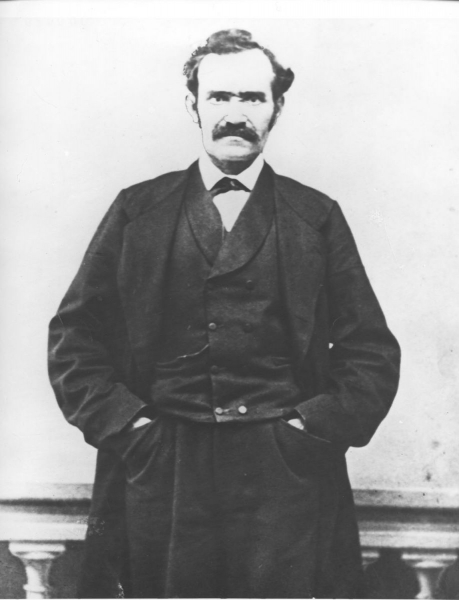 The Pellier family and their descendants have been long time Property and Business Owners in San Jose and Evergreen since the late 1840’s. Though one of the murals is designed specifically for the descendants of the Pelliers, I have another mural for what I’m calling the “Pellier Contribution” to San Jose and the Santa Clara Valley.
The Pellier family and their descendants have been long time Property and Business Owners in San Jose and Evergreen since the late 1840’s. Though one of the murals is designed specifically for the descendants of the Pelliers, I have another mural for what I’m calling the “Pellier Contribution” to San Jose and the Santa Clara Valley.
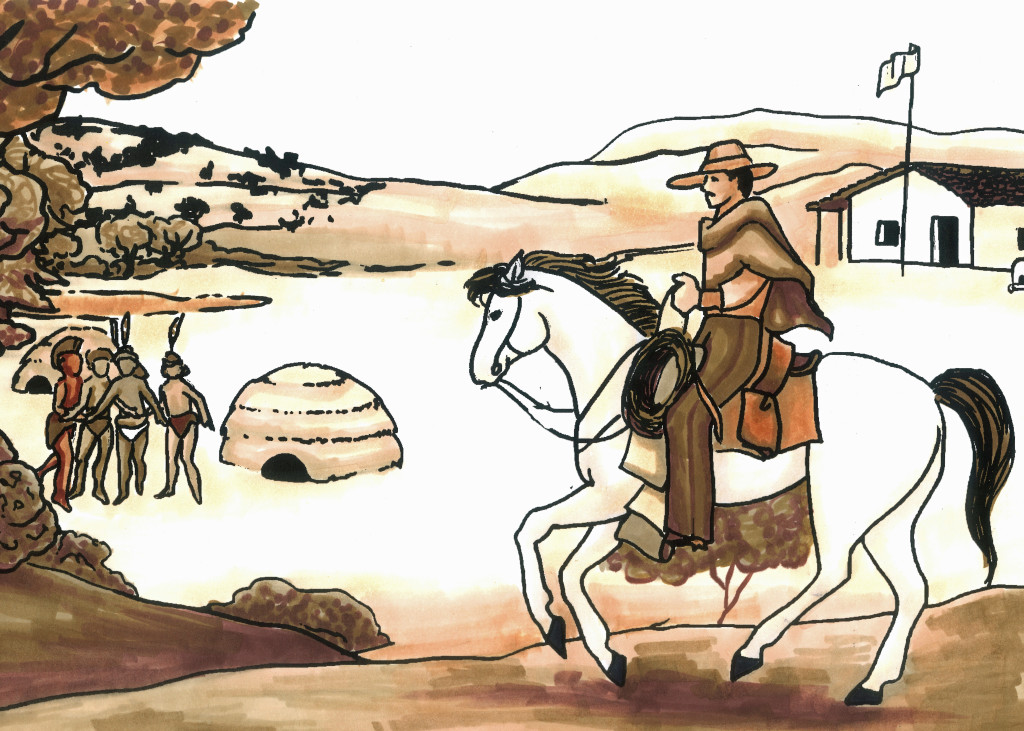 Mini-History lesson: The Spanish Missions ran the agricultural business and mostly did business with the local naval bases that protected them. The Indians were the farmers and the monks participated as well. However, when California became Mexican Territories, the missions closed down and the Indians were displaced. The vineyards and orchards went dry and much of the valley turned to cattle pasture.
Mini-History lesson: The Spanish Missions ran the agricultural business and mostly did business with the local naval bases that protected them. The Indians were the farmers and the monks participated as well. However, when California became Mexican Territories, the missions closed down and the Indians were displaced. The vineyards and orchards went dry and much of the valley turned to cattle pasture.
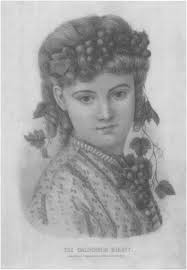 Louis Pellier (1817-72), son of winemakers outside of Bordeaux, had plenty of experience keeping the family farm. At the age of 32, Louis left France during the French Revolution and traveled around Cape Horn to arrive in San Francisco in 1847-8. Louis sent for his brother, Pierre, and they found success gold mining in Weaverville. Pierre served in the French Army during the revolution and came to California in 1849.
Louis Pellier (1817-72), son of winemakers outside of Bordeaux, had plenty of experience keeping the family farm. At the age of 32, Louis left France during the French Revolution and traveled around Cape Horn to arrive in San Francisco in 1847-8. Louis sent for his brother, Pierre, and they found success gold mining in Weaverville. Pierre served in the French Army during the revolution and came to California in 1849.
Louis quickly realized that there were going to be a flood of people coming to California for the Gold Rush and American Dream. The price of the limited produce was extremely high. With family in France and experience he gained on the family farm, Louis could get into that business. Pierre came to California in 1849 in search of gold, but the Pellier brothers returned to their native country several times in search of a different kind of gold.
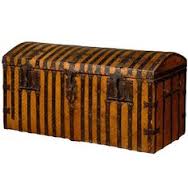
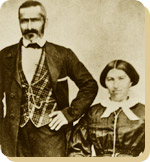 On their 1850’s journeys, Pierre brought back his long lost sweetheart, Henriette Renaud. Louis realized his business plans. Louis, Pierre and Jean, the Pellier brothers, stretched out across France, looking for fruit and vegetable varieties to repopulate the rich soil of the Santa Clara Valley. Not all of the plants would arrive alive when traveling by boat. There was a fair amount of learning taking place in the process. In steamer trunks and barrels, the brothers brought seeds, small potted plants and clippings to propagate once back in California.
On their 1850’s journeys, Pierre brought back his long lost sweetheart, Henriette Renaud. Louis realized his business plans. Louis, Pierre and Jean, the Pellier brothers, stretched out across France, looking for fruit and vegetable varieties to repopulate the rich soil of the Santa Clara Valley. Not all of the plants would arrive alive when traveling by boat. There was a fair amount of learning taking place in the process. In steamer trunks and barrels, the brothers brought seeds, small potted plants and clippings to propagate once back in California.
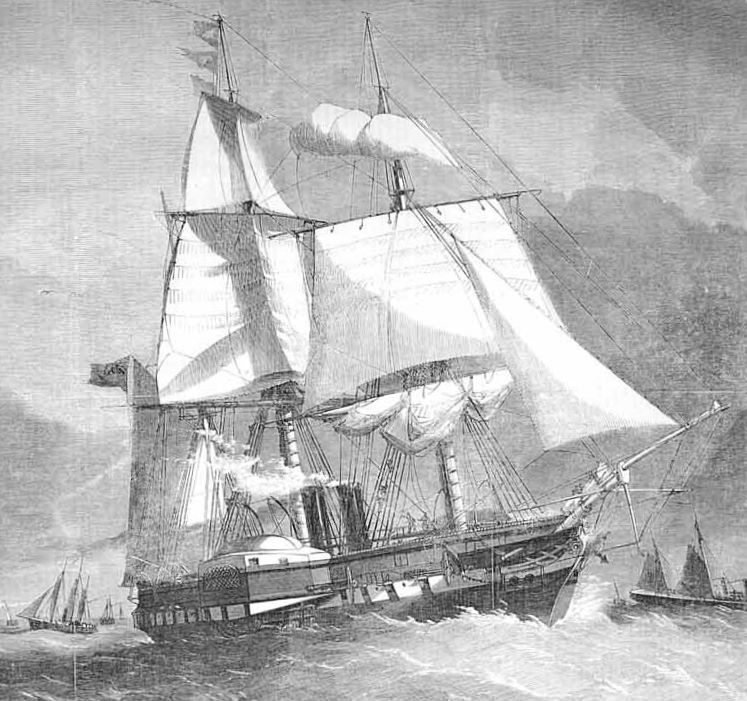 The brothers improvised when water ran low, presumed to be due to underestimation on the first journey. They kept the clippings alive by inserting them into potatoes for moisture, which worked well.
The brothers improvised when water ran low, presumed to be due to underestimation on the first journey. They kept the clippings alive by inserting them into potatoes for moisture, which worked well.
The Pellier brothers brought some other notable names, the very young Delmas brothers, to California with them. The brothers made considerable amounts of money and bought large plots of land in San Jose and east of San Jose. Unfortunately, the Pelliers sold all their stock of seeds off the dock of Alviso, which meant they had nothing to plant for themselves after the first voyage. This created the necessity of return trips to France, possibly crossing through Panama by train on their way back to California.
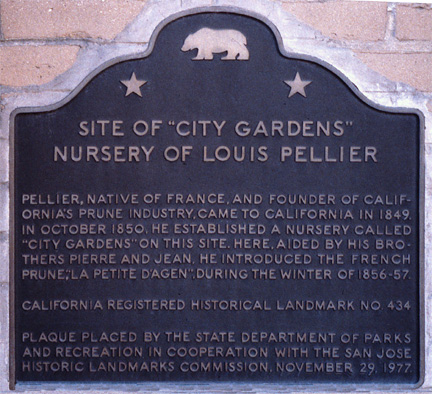 Louis Pellier founded City Gardens Nursery in 1850 with Pierre, at the present day corner of St. James Street and San Pedro Street. The Pellier prune clippings were grafted on to wild Californian prunes, and arranged into rows making the first California prune orchards in 1856. City Gardens was open to the public for picnics and for the nuns to pick freely. The prune was a success, and City Gardens was a cultural hub of Downtown San Jose. The California Prune Industry and Valley of Heart’s Delight radiated outward from the Downtown Pellier orchards. This, however, will be a forgotten garden. The Pellier’s other pride lies east of San Jose in the 1860’s.
Louis Pellier founded City Gardens Nursery in 1850 with Pierre, at the present day corner of St. James Street and San Pedro Street. The Pellier prune clippings were grafted on to wild Californian prunes, and arranged into rows making the first California prune orchards in 1856. City Gardens was open to the public for picnics and for the nuns to pick freely. The prune was a success, and City Gardens was a cultural hub of Downtown San Jose. The California Prune Industry and Valley of Heart’s Delight radiated outward from the Downtown Pellier orchards. This, however, will be a forgotten garden. The Pellier’s other pride lies east of San Jose in the 1860’s.
 Louis and Pierre bought land in Evergreen, which was once part of the Chaboya Land Grant or Rancho Yerba Buena. When Louis sold his portion to Pierre, it became one of the largest ranches in the township of Evergreen.
Louis and Pierre bought land in Evergreen, which was once part of the Chaboya Land Grant or Rancho Yerba Buena. When Louis sold his portion to Pierre, it became one of the largest ranches in the township of Evergreen.
Louis Pellier had a spat with his brothers, presumed to be due to the sale of all the plants or the neglect of their orchards on one of his journeys to France. Pierre took his horticultural skills and expertise to his ranch and vineyards in Evergreen. Louis stayed downtown. Louis took a wife, a woman of French heritage, who wasn’t well suited for him. She quite possibly drove him mad, possibly creating the wedge between brothers.
Don’t worry. There was a lot of love there between the Pellier brothers, even towards the end. Pierre even named his first son after his brother. In 1872, Louis died in a state hospital, due to a nervous breakdown after the separation with his wife. He and his wife had no children. His brother, Pierre, took care of the estate, and the family decided to pay-off the widow with proceeds of the Downtown property. There was a Will in place, but the greedy widow kept coming back for more until a cash settlement was reached.
 Louis’s amazing business venture wouldn’t reach its height for many years. In 1929, California would cultivate 171,330 acres of prune orchards. The La Petite D’Agen from France grafted onto the wild prunes proved to be perfect for California. It was fruitful or meaty enough to be dried, making the prune easy to export all over the country. The growth of the railway system made the export possible. Pierre Pellier brought back the Black Burgundy, French Colombar, Chasselas, Fontainebleau, Pinot Noir, Madeline and others from France. With these new varieties, Louis and Pierre Pellier founded the Valley’s French wine industry at City Garden Nursery.
Louis’s amazing business venture wouldn’t reach its height for many years. In 1929, California would cultivate 171,330 acres of prune orchards. The La Petite D’Agen from France grafted onto the wild prunes proved to be perfect for California. It was fruitful or meaty enough to be dried, making the prune easy to export all over the country. The growth of the railway system made the export possible. Pierre Pellier brought back the Black Burgundy, French Colombar, Chasselas, Fontainebleau, Pinot Noir, Madeline and others from France. With these new varieties, Louis and Pierre Pellier founded the Valley’s French wine industry at City Garden Nursery.
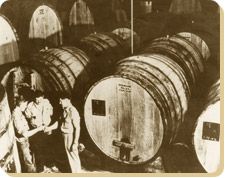 Pierre Pelliers’s vineyards and orchards a few miles east of San Jose would get passed down to his five children, who later became vineyard owners and winemakers themselves, following in the Pellier’s footsteps, even through Prohibition. The descendants of the Pellier brothers would, in fact, become one of, if not the, most famed business out of Evergreen. The family still has living descendants in family house in the neighborhood. They deserve their own mural in my humble opinion.
Pierre Pelliers’s vineyards and orchards a few miles east of San Jose would get passed down to his five children, who later became vineyard owners and winemakers themselves, following in the Pellier’s footsteps, even through Prohibition. The descendants of the Pellier brothers would, in fact, become one of, if not the, most famed business out of Evergreen. The family still has living descendants in family house in the neighborhood. They deserve their own mural in my humble opinion.
Here’s a look at the artwork I have planned for the “Pellier Contribution.” 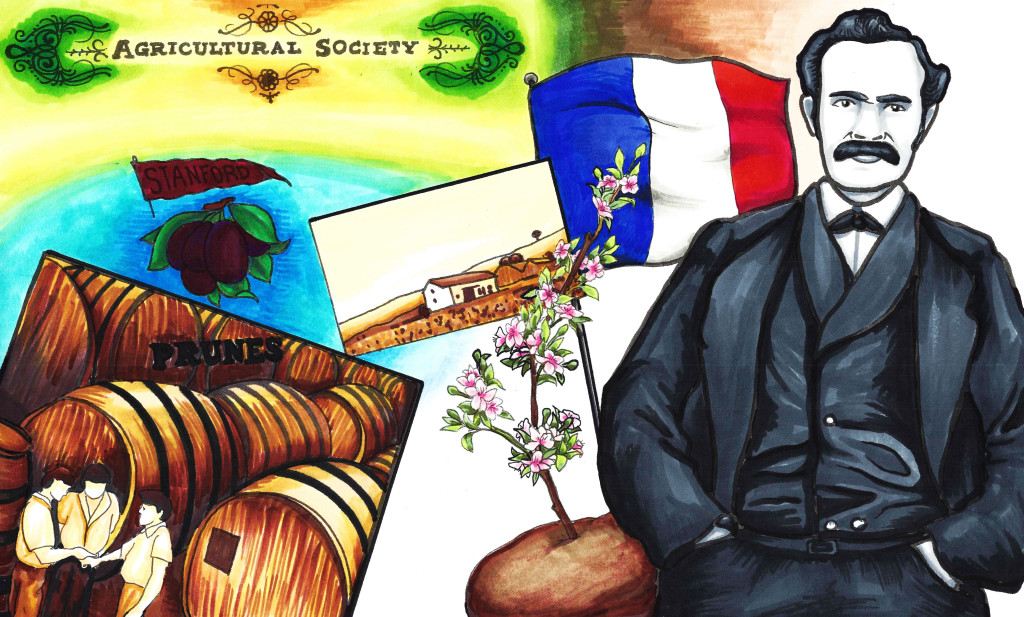

Thanks so much for that. I never get tired of reading it and having grown up on the Vineyards in Evergreen and working in the family business until 19 84 I have learned that I had the perfect childhood and early adulthood. There’s nothing like being with agriculture.
I had a friend in Madera, and he used to tell a story that as a child he would go with his father on their truck, which made it an overnight event, to come to Santa Clara Valley. He said every time they reach the top of highway 152 his father would stop the truck and say son you were about to enter the most fertile valley on earth. He said there was nothing that wouldn’t grow here.
So now we produce silicon chips. I guess somebody found a more profitable crop.